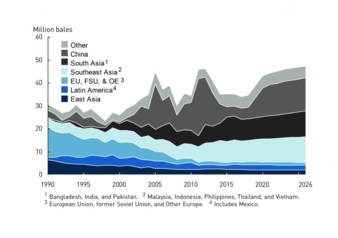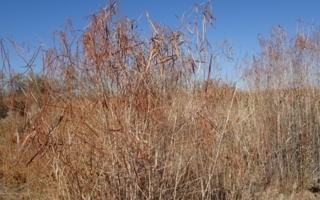08/09/2017 – Cotton — auf Deutsch lesen
World Cotton Trade until 2026/27
3.8 Percent annual growth rate.
World cotton trade is projected to increase at a 3.8 percent annual growth rate between 2017/18 and 2026/27 as it recovers from a sharp decline during the period 2013/14 to 2017/18 that reflected reduced imports by China. World cotton trade rises after China disposes of large reserve stocks and increases imports. Projected world cotton trade surpasses the 46.4-million-bale record set in 2012/13, reaching 47.4 million bales in 2026/27.
China’s cotton imports are expected to increase throughout the next decade with stronger growth in the second half of the projection period. After a sharp decline in recent years, China’s cotton imports are expected to resume growth in 2019/20, with an average annual increase of 13 percent over the projection period. China increases imports by about 9.6 million bales with imports at 14.4 million bales in 2026/27.
In 2014, China modified its cotton support program and began drawing down large cotton stocks. By allowing domestic cotton prices to fall, China is expected to recover part of the share of world cotton consumption it lost between 2009 and 2013. Some textile production shifted from China to other countries during those years. India, Bangladesh, Pakistan, and Vietnam have been major beneficiaries of this shift. Bangladesh became the world’s largest cotton importer in 2015/16, but is projected to be surpassed by China in 2019/20. Bangladesh remains the second-largest importer through 2026/27 as its textile industry grows rapidly.
Vietnam, Turkey, Indonesia and Pakistan are expected to be the third-, fourth-, fifth- and sixth-largest cotton importers throughout the projection period. Vietnam’s cotton imports increased more than five-fold over the past decade and are projected to account for 15 percent of the world’s increased imports to 2026/27. Vietnam’s textile sector and cotton imports are expected to grow 3.9 percent annually in the coming decade. Turkey’s share of world consumption has weakened recently, and imports are expected to remain flat through the projection period.
Indonesia’s cotton imports increase but do not surpass Turkey. Indonesia remains the fifth largest cotton importer throughout the projection period, with imports projected to grow at an annual average rate of 1.1 percent, increasing to 3 million bales. Pakistan’s cotton imports are projected to slightly decrease by 2026/27. Pakistan’s new Bacillus thuringiensis (Bt) cotton varieties specific to Pakistan’s cotton-growing conditions stimulate additional production.
Imports by Mexico, Thailand, Japan, South Korea, and Taiwan all decrease slightly throughout the projection period, with a combined decrease in imports of 0.62 million bales by 2026/27.
Source: USDA Agricultural Projections to 2026




